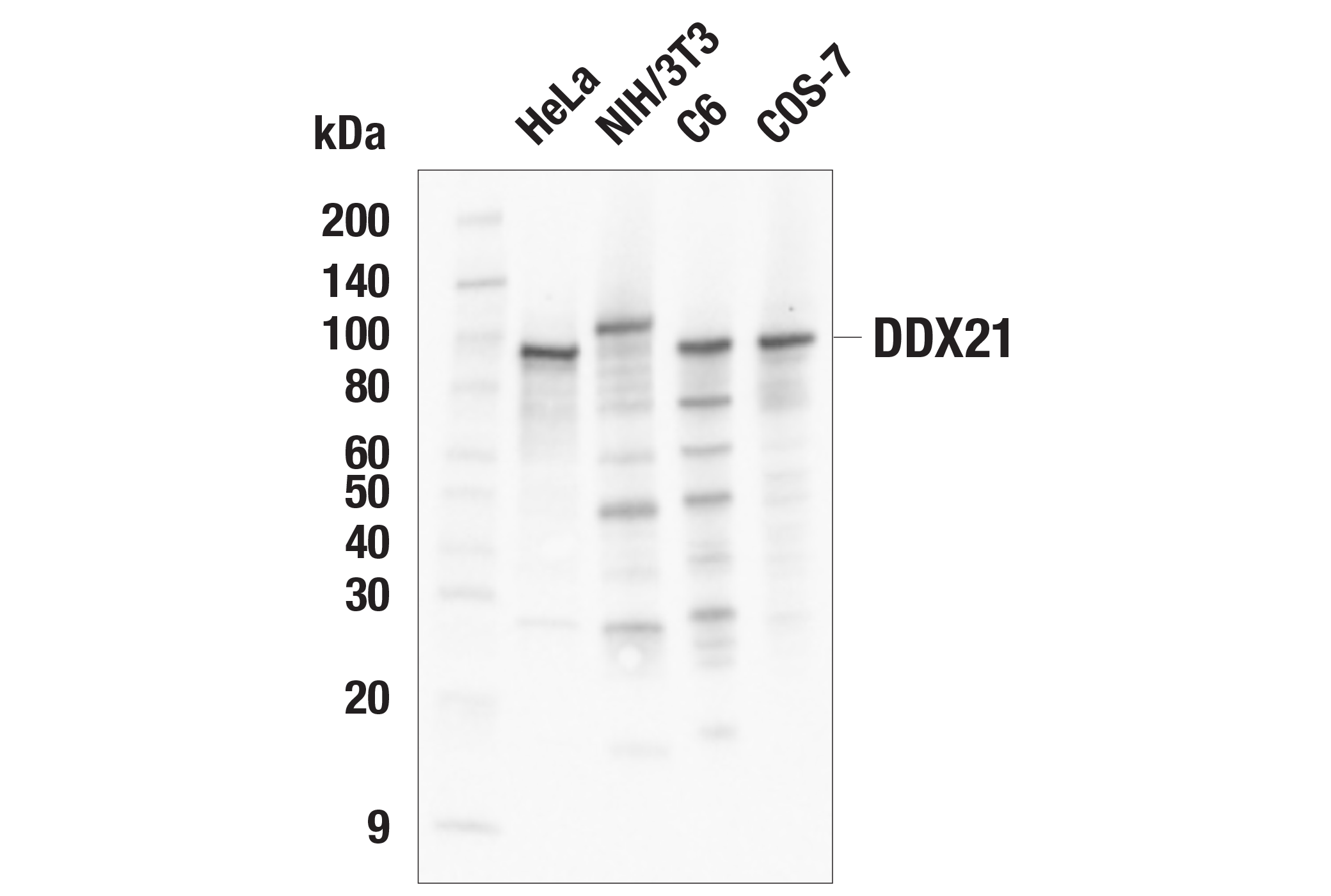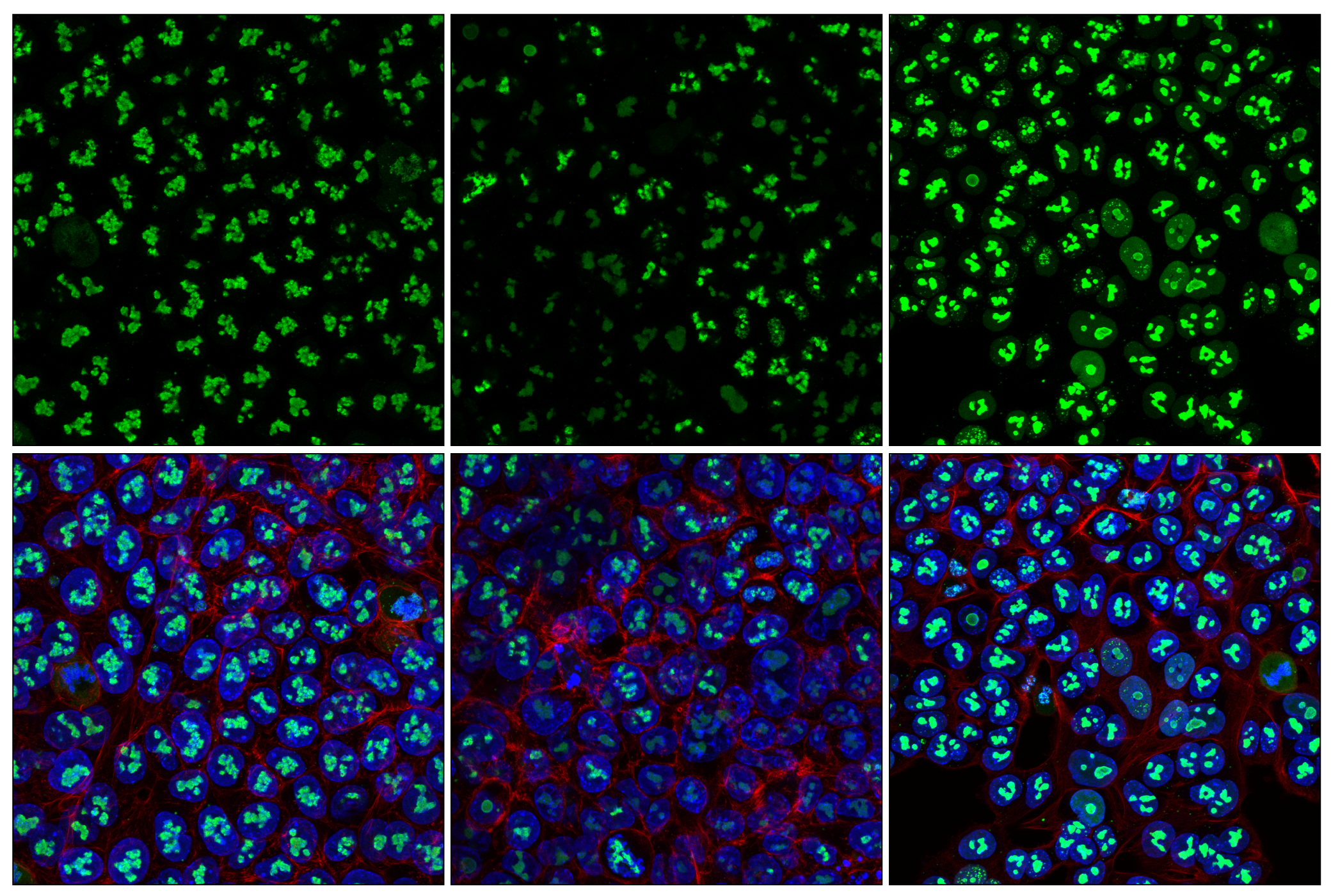WB, IF-IC
H M R Mk
Endogenous
100
Rabbit IgG
#Q9NR30
9188
Product Information
Product Usage Information
| Application | Dilution |
|---|---|
| Western Blotting | 1:1000 |
| Immunofluorescence (Immunocytochemistry) | 1:100 - 1:400 |
Storage
Specificity / Sensitivity
Species Reactivity:
Human, Mouse, Rat, Monkey
Source / Purification
Monoclonal antibody is produced by immunizing animals with a synthetic peptide corresponding to residues surrounding Ala780 of human DDX21 protein.
Background
DDX21, also known as RNA helicase II/Gu, is an RNA helicase that plays important roles in transcription and ribosomal RNA (rRNA) processing (1-3). DDX21 associates with many RNA Polymerase I and II genes, including the direct binding to the rDNA locus to promote ribosome biogenesis. The helicase activity of DDX21 contributes to transcription by helping release P-TEFb from the 7SK small nuclear ribonucleoprotein (snRNP) complex (3). Nucleolar localization of DDX21 has been shown to be regulated through phosphorylation by JNK and interaction with c-Jun. Depletion of either c-Jun or JNK has shown to impair rRNA processing (4,5). DDX21 can also become acetylated by CBP, which reduces its activity. Deacetylation by SIRT7 increases DDX21 helicase activity to prevent R-loop accumulation and protect genomic stability (6). DDX21 can also form a complex with DDX1, DHX36, and TRIF to sense dsRNA, which in turn activates interferon response in innate immunity (7,8).
- Yang, H. et al. (2003) J Biol Chem 278, 38847-59.
- Henning, D. et al. (2003) J Biol Chem 278, 52307-14.
- Calo, E. et al. (2015) Nature 518, 249-53.
- Holmström, T.H. et al. (2008) J Biol Chem 283, 7046-53.
- Mialon, A. et al. (2008) FEBS Lett 582, 3145-51.
- Song, C. et al. (2017) Genes Dev 31, 1370-1381.
- Zhang, Z. et al. (2011) Immunity 34, 866-78.
- Tsai, S.Y. et al. (2014) PLoS Pathog 10, e1003848.
Species Reactivity
Species reactivity is determined by testing in at least one approved application (e.g., western blot).
Western Blot Buffer
IMPORTANT: For western blots, incubate membrane with diluted primary antibody in 5% w/v BSA, 1X TBS, 0.1% Tween® 20 at 4°C with gentle shaking, overnight.
Applications Key
WB: Western Blotting IF-IC: Immunofluorescence (Immunocytochemistry)
Cross-Reactivity Key
H: human M: mouse R: rat Hm: hamster Mk: monkey Vir: virus Mi: mink C: chicken Dm: D. melanogaster X: Xenopus Z: zebrafish B: bovine Dg: dog Pg: pig Sc: S. cerevisiae Ce: C. elegans Hr: horse GP: Guinea Pig Rab: rabbit All: all species expected
Trademarks and Patents
Limited Uses
Except as otherwise expressly agreed in a writing signed by a legally authorized representative of CST, the following terms apply to Products provided by CST, its affiliates or its distributors. Any Customer's terms and conditions that are in addition to, or different from, those contained herein, unless separately accepted in writing by a legally authorized representative of CST, are rejected and are of no force or effect.
Products are labeled with For Research Use Only or a similar labeling statement and have not been approved, cleared, or licensed by the FDA or other regulatory foreign or domestic entity, for any purpose. Customer shall not use any Product for any diagnostic or therapeutic purpose, or otherwise in any manner that conflicts with its labeling statement. Products sold or licensed by CST are provided for Customer as the end-user and solely for research and development uses. Any use of Product for diagnostic, prophylactic or therapeutic purposes, or any purchase of Product for resale (alone or as a component) or other commercial purpose, requires a separate license from CST. Customer shall (a) not sell, license, loan, donate or otherwise transfer or make available any Product to any third party, whether alone or in combination with other materials, or use the Products to manufacture any commercial products, (b) not copy, modify, reverse engineer, decompile, disassemble or otherwise attempt to discover the underlying structure or technology of the Products, or use the Products for the purpose of developing any products or services that would compete with CST products or services, (c) not alter or remove from the Products any trademarks, trade names, logos, patent or copyright notices or markings, (d) use the Products solely in accordance with CST Product Terms of Sale and any applicable documentation, and (e) comply with any license, terms of service or similar agreement with respect to any third party products or services used by Customer in connection with the Products.

